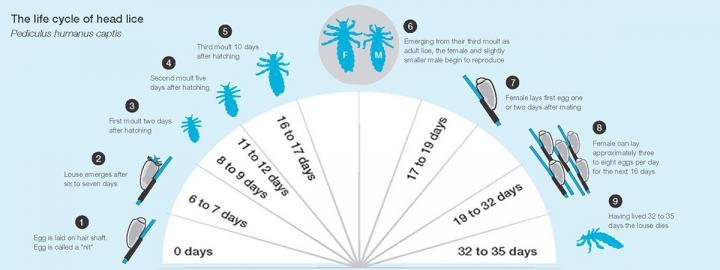
Head Lice Treatment
ADVERTISEMENT
Several years ago I got lice from one of my children's neighborhood friends. My hair is very long (hip length), and I had no intention of cutting it. There's no way I could even think about getting a nit comb through it, either, so the first thing I did was thoroughly rinse my hair with apple cider vinegar (which happens to be good for hair, but not for lice). After that, I liberally applied olive oil all over my hair/scalp and wrapped a towel around my hair/head (this treatment helps suffocate lice). I kept the towel on my head for a good hour. Afterward, I washed my hair enough times to get the oil out and then used a blow dryer to dry my hair. I read an article by an entomologist about killing lice, because he accidentally did it during one of his studies (he moved to a drier climate, and the dryness killed his lice). If you dehydrate the lice, which happens when using a blow dryer, they die. It also dehydrates their eggs (so they don't hatch) and renders any surviving lice sterile. You only have to blow dry your hair on the hottest setting you can stand for as long as you can stand (be sure to get as close to your scalp as you can, too). I only had to do this for 2-3 days and never again after that. In the meantime, I made sure to cover cloth furniture with plastic and sprinkle the carpet with baking soda (it dehydrates).
Over-the-counter products no longer work because the lice have grown resistant to those products. If you want to get rid of them in one 10 minute application with no nit combing, ask your doctor to prescribe Spinosad. It kills the live lice and the nits. It’s also very safe.
Every year, my neighbor (a elementary school teacher) shaves every head in her family of four!
She's tired of lice. It was stunning at first. This year they used colored dyes or Koolaid to add some fun. Or she'll have the barber shave fun designs or words. She wears scarves and bands and big earrings when going to work. The 2 kiddos never struggle to have friends either. Not for everyone but just an idea...
When my sons got lice, I was told to use the shampoo, then use the comb for a manual removal and then blow dry their hair because the heat would help kill rid of any residual eggs.
I have tried all OTC products,olive oil,tea tree oil,mayonnaise,petroeum jelly,lemon juice,household lice spray,a 300 dollar prescription and have suffered for 12 months.I keep plastic wrap on my head constanty and no longer see friends or pursue normal activities. Im thinking of shaving my head. Im a 60 y.o. female who doesnt even feel like a woman anymore. Can anyone suggest anything to help me???
I would like to send you my invention if you are still suffering from the lice? Maybe Margaret can give you my email adres, so you can send me your adres. Good luck! Nicolette
Head lice are tiny wingless insects that cannot jump or fly. They survive on the human head by sucking blood from the scalp. Lice are not dangerous, do not carry diseases and are not a sign of poor hygiene. During their life cycle, they also lay eggs in your hair. These eggs are called nits. Head lice are common in overcrowded places, especially in the schools.
My mother, who taught 2nd grade from 1949 thru 1956 (quitting only to raise 4 children of her own) told me, once, that it was normal, back in her teaching days, to utilize actual DDT powder, to kill head lice.
Mind you, this was long before it was banned for use, in the USA.
My friend actually used coal oil on her kids heada as that is what she heard was done yrs ago.. except she left on to long and burned their scalps.. poor kids
Yes I have always used the treatments when my kids had it always getting it at school I use to get so mad over that too people need to keep there kids at home when they have head love no go ahead and send them to school I had too clean everything pillows and blankets sheets clothes towels the entire home the best I had found when be the Nix it always worked. I know someone who used dog shampoo to get rid of it also RID that's no count.









